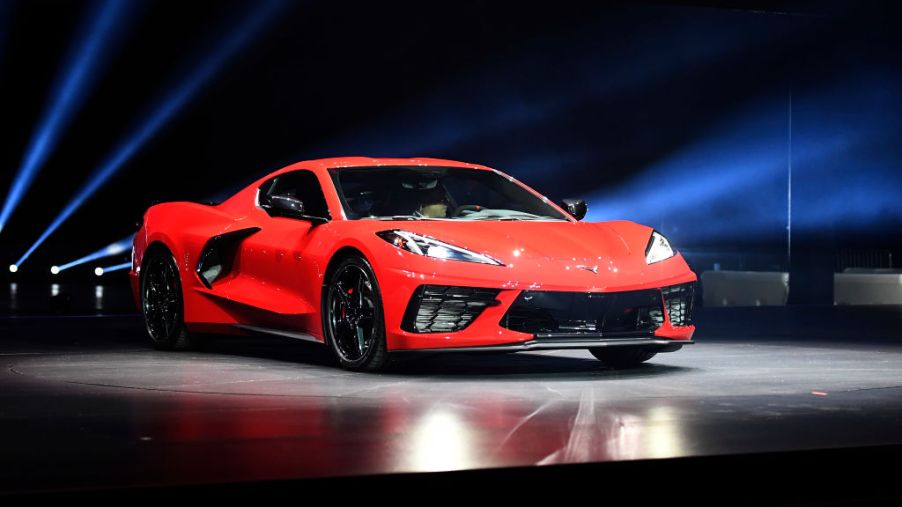
Is the 2020 Corvette Stingray Made in America?
Chevy has been promising the world a production mid-sized Stingray for quite some time, and it’s finally here! Only time will tell if the wait was truly worth it, as the 2020 C8 has some steep competition from previous models such as the ’63 Stingray. But Kelley Blue Book can’t stop raving about how “assertive and yet tasteful” the 2020 Stingray looks.
While the rest of the world has been eagerly awaiting the arrival of the new C8, the 2020 Stingray will make Americans proud in particular, as it first hit production lines in Chevy’s Bowling Green factory located in Kentucky, making it a truly American car.
It may be questionable whether the Stingray is a muscle car or a sports car—even though it’s typically marketed as a sports car—since it has a V8 engine, and even better, is affordable. Either way, it’s still an amazing car.
With that in mind, we want to take a look at the history of American made muscle cars, so that we can see how far we’ve come and look back at some of the classics that no new model will ever be able to dethrone.
Which car is the ‘original’ muscle car?
That’s the question of which has possibly started more heated arguments than asking someone what they would like for dinner. Just trying to peg down a year is controversial, as some say it all began in late 1949 with the Oldsmobile 88′ Rocket and others say that while there were some nice cars back then, true muscle cars didn’t hit the streets until the ’60s. Everyone’s got an opinion and it’s based largely on their own personal favorite.
For the sake of keeping the peace, let’s take a look at the group that inspired automakers to begin producing muscle cars.
Bootleggers
In 1920, the American government passed the Prohibition Act, which essentially said that the sale of liquor was illegal. Since it can be difficult to quit ‘cold turkey’ it came as no surprise to anyone when bootleggers began to produce their own liquor.
Some were actually sold in drug stores as medicine, so long as the customer had a prescription, but not everyone could get this. Delivering it to buyers was a problem however, as the roads were watched carefully by police.
Runners who transported the illegal goods from the stills to their customer base needed fast cars to outrun the police, and during this time period, you couldn’t just buy a fast car.
So being the ingenious lot they were, bootleggers began to modify their own by installing extra carburetors, extra suspension springs, and replacing engines. The bootlegger car of choice was the 1940 Ford.
The drivers soon began to become famous in their own right. Competition soon began to grow over who was the best driver and who had the fastest car. Thus began stock car racing, which soon gave birth to NASCAR.
Making muscle cars legal
Everyone didn’t have the money to ‘soup-up’ their own cars or the skills, but the demand for fast cars was strong. Seeing this, American automakers realized the real opportunity on their hands, and they seized it.
The History Channel gives Pontiac credit for jump-starting the muscle car craze in 1964 by giving Americans the first ‘option’ of adding in a V8 engine in the smaller model GTO. Thus, making it the first trim package to be offered by an automaker. Pontiac was owned by GM, as well as Buick, Oldsmobile, and Chevrolet, and the competition was on in the GM family.
Not wanting to let one of its internal brand competitors best them, Buick, Oldsmobile, and Chevy began to produce its own muscle cars. The Skylark, Chevy SS, and the Nova were some of the first mass-produced ‘muscle cars’ after the GTO.
The craze for small cars with big engines grew like wildfire and other automakers wanted a piece of the action. Ford and Dodge quickly made marks with the Mustang and the Charger. The rest, as they say, is history.
Chevy Corvette Stingray
So how does the Chevy Stingray fit into American muscle car history? Well, the first Stingray hit the streets in 1963, and it was equipped with a V8 engine.
In 1965 when Chevy souped-up the Stingray’s power even more by adding a “big block,” 6.5 L (396 c.i.) V-8 engine. In fact, every Stingray to hit the market has a V8 engine under the hood. The Stingray has the label of a sports car, but it may just have the heart of a muscle car. Not to mention, it can still proudly claim to be an American made car.


